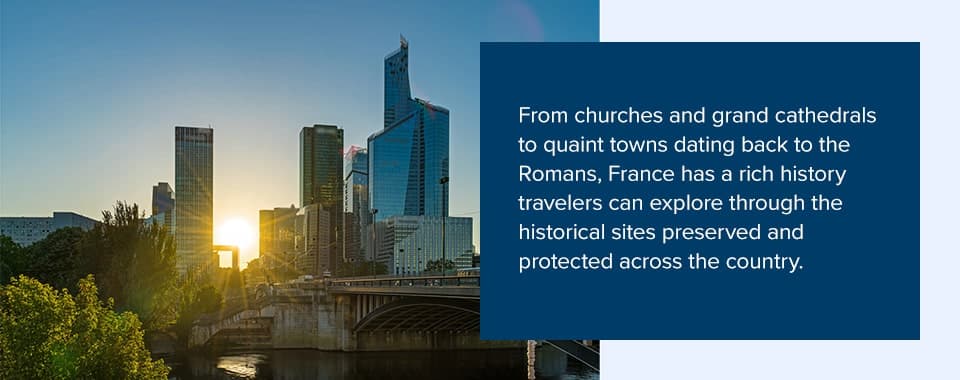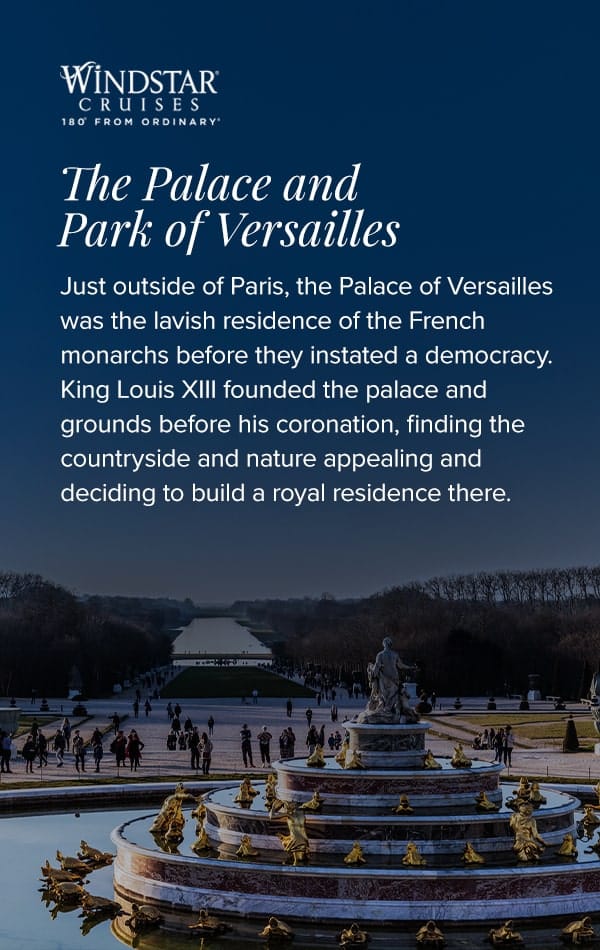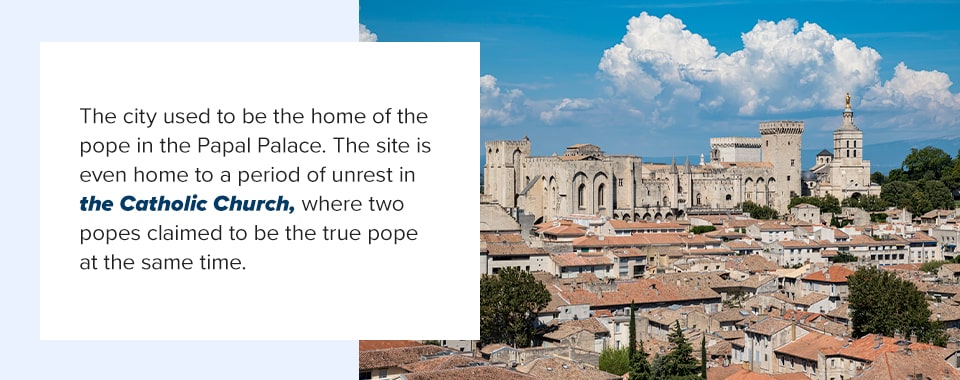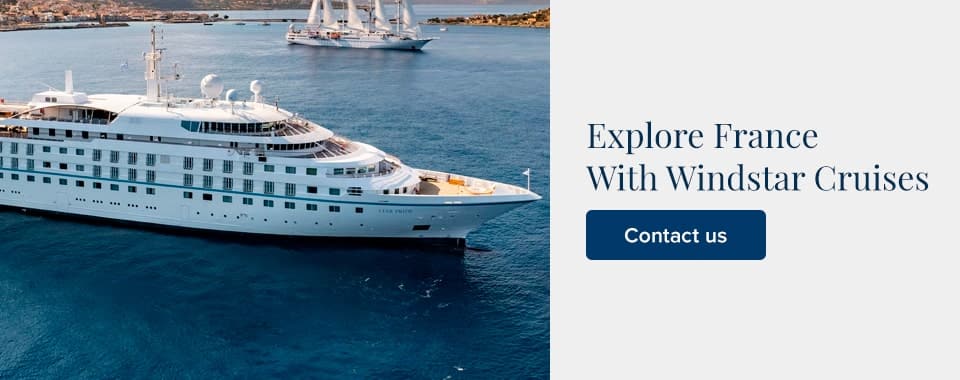
The United Nations Educational, Scientific and Cultural Organization (UNESCO) protects important sites globally by designating them as World Heritage Sites. Many travelers choose to visit these locations when exploring new countries because they allow individuals to learn more about the history and culture of a place while enjoying beautiful scenery. When visiting France, you can unlock your next favorite destination through its many UNESCO World Heritage Sites.
In This Article
- How Many UNESCO Sites Are in France?
- 11 Best UNESCO World Heritage Sites in France
- Explore France With Windstar Cruises

How Many UNESCO Sites Are in France?
France is home to over 40 UNESCO World Heritage Sites. From churches and grand cathedrals to quaint towns dating back to the Romans, France has a rich history travelers can explore through the historical sites preserved and protected across the country. The diversity and vast spread of UNESCO sites in France ensure you can find the perfect item to add to your France itinerary, whether you are staying in romantic Paris or exploring the southern lavender fields.
11 Best UNESCO World Heritage Sites in France
When planning your trip to France, knowing the best UNESCO World Heritage Sites can direct your attention to some of the most beautiful and culturally significant locations the country has to offer. With so many to choose from, narrowing your options down can help you better plan and prepare for your time in France.

1. The Palace and Park of Versailles
Just outside of Paris, the Palace of Versailles was the lavish residence of the French monarchs before they instated a democracy. King Louis XIII founded the palace and grounds before his coronation, finding the countryside and nature appealing and deciding to build a royal residence there.
However, it was his son, King Louis XIV, that made Versailles famous. Nicknamed the Sun King, the monarch wanted court life to better revolve around him, so he moved the French court permanently to Versailles rather than moving between residences seasonally.
He built the famous Hall of Mirrors, which shimmers like the sun with the glass mirrors expanding the space and light glittering on the gold detailing. Here, the Sun King would throw lavish parties for his court and international visitors, showing off the luxuries of his country that travelers can still enjoy today. This tradition was carried on by Marie Antoinette, the infamous queen before the French Revolution. She moved to the palace after her marriage to the Sun King’s son, King Louis XVI.
Travelers can explore Versailles’ various bedrooms, antechambers and halls, all decorated in gold and silk that highlighted the French monarchy’s wealth. Art dons the walls, showcasing France’s rich history and culture. Outside, you can peruse traditional French gardens, complete with hedges, fountains, statues and beautiful flowers.
2. The Banks of the Seine
When in Paris, you can enjoy a romantic stroll along the Seine and a UNESCO World Heritage Site. UNESCO protects a portion of the riverbank that borders and overlooks many iconic Parisian sites, making it easy to appreciate the best French capital has to offer. The protected riverbank includes the Eiffel Tower, the Louvre, Ile St Peter, Pont Neuf, the Petit Palais and the Place de la Concorde. From here, you can view the Sainte Chapelle.
Together, these landmarks can fill your Paris itinerary while giving you an overview of French history through its architecture. Each monument represents a different architectural age, from Renaissance to Gothic and Classical.
3. Mont-Saint-Michel
France is full of stunning, larger-than-life churches and monasteries. Mont-Saint-Michel is an abbey built on a tidal island in Normandy. The buildings have survived countless wars due to their strategic location in the center of a marsh, where the quick-changing tides and unstable sand foundation can turn deadly in minutes to invaders who don’t know the schedule of the tides.
Today, there is a bridge that allows visitors to safely visit the complex and meander through the narrow, steep streets to the abbey dedicated to Saint Michael at the top. The abbey is still in use, but travelers can explore it. Since its foundation in the eighth century, this holy space served as an important pilgrimage site to the faithful, and you can retrace history’s steps by making the trek up the steep steps to the complex.
While the abbey is situated at the top of the island, cute shops and restaurants are situated in the space below it, providing plenty to do on the island. Mont-Saint-Michel is famous for its fluffy omelets, making them a must-try when visiting.
4. Chartres Cathedral
If you love Gothic architecture, historians and architects acclaim the Chartres Cathedral as one of the best-preserved examples of the French Gothic style. The church boasts around 4,000 sculpted figures on its facade and interior, highlighting the incredible detail of the era. Many scenes demonstrate important stories from the Bible, and travelers can pick out figures like John the Baptist amongst the sculptures. Their configuration and composition add a 3D effect, adding depth and shadows to the scenes.
Inside, the cathedral has vaulted ceilings supported by columns that together draw the eye upwards toward the heavens. With the largest collection of stained glass in the world, the Chartres Cathedral is vibrant with color. Full of scarlet, emerald and ruby hues, the 176 stained glass windows tell more scenes from the Bible and wash the cathedral in gem tones and shadows.
This church was once a common stop for pilgrimages. Like many Catholic churches and cathedrals, this religious space houses holy relics. The Chartres Cathedral is home to the veil the Virgin Mary wore while delivering Jesus.
5. Vézelay
Another important pilgrimage site, Vézelay celebrates Mary Magdalene. Located in central France near the Burgundy region, Vézelay is a rural town and a Benedictine monastery. The monastery rose in importance from the relic housed here — the monastery has bones said to be from Mary Magdalene.
The monastery sits atop a hill, overlooking a classic, romantic town. After exploring the church, you can meander through the little streets and stop in the quaint shops. The village is the perfect country destination for those trying to find a quiet escape from the cities.

6. The Historic Center of Avignon
In the south of France, Avignon highlights the medieval history of the country. Avignon sits on the River Rhone, and it is rich with medieval architecture, transporting travelers back in time as they walk along the ramparts or over the stone bridge.
The city used to be the home of the pope in the Papal Palace. The site is even home to a period of unrest in the Catholic Church, where two popes claimed to be the true pope at the same time. The Western Schism involved one pope in Rome and another in Avignon. Today, travelers can explore the Papal Palace and its vaulted ceilings and symmetrical towers.
The Notre-Dame-des-Doms Cathedral, also called the Avignon Cathedral, is another example of medieval architecture, representing the Romanesque period. The white stone stands tall, topped with a tower of the Virgin Mary, who shines in her gilded gold in the sunlight.
Avignon and its bridge are the subjects of a popular children’s nursery rhyme. French kids grow up singing “sur le pont d’Avignon,” which has an accompanying dance. It discusses dancing over the Saint-Bénézet Bridge — a medieval structure still standing and providing passage over the Rhone.
7. Pont du Gard, Nimes
The Pont du Gard is perfect for those who love ancient history. This monument is a marvel leftover from when the Romans occupied France. The Pont du Gard served as an aqueduct, carrying fresh water into the town. With three tiers of arches, it is an incredible feat of engineering, made even more impressive by how well it has withstood the passage of time.
Clear water flows under the Pont du Gard, making it a popular swimming location in the summer. When trying to escape the southern heat or enjoy a peaceful day outside, you can wade along the banks, kayak, sunbathe and swim at Pont du Gard.
8. Roman Monuments in Arles
Roman influence is all over southern France, highlighting the ingenuity and strength of the Roman empire during its height. Nestled along the Rhone River in the Provence region, Arles sports several testaments to the French Roman era, including:
- Arles Amphitheater: When in Rome, you have the Colosseum. When in Arles, you have the Arles Amphitheater. The parallels in the designs between the Roman Colosseum and this local amphitheater highlight the Roman design and give you a taste of what Ancient Roman life might have been like. The arches and circular structure are very well preserved, so you can imagine the glorious gladiator fights that once took place here.
- Thermes de Constantin: Roman baths are another staple of Ancient Roman culture. These spaces allowed individuals to gather, socialize and bathe. These baths specifically were the hot pools that allowed Romans to unwind and relax. Today, visitors can walk through the structures to understand an important aspect of Roman culture.
- Alyscamps: The Alyscamps is the Roman necropolis in Arles. At its height, this location would have boasted Roman mausoleums, which feature sculptures and reliefs dedicated to the families and individuals buried there. Today, the structure is mainly ruins, but visitors can still walk along the tree-lined paths to imagine what the space might have looked like.
While Arles is great for exploring Roman history, it has much more to do. Arles was also once the home to Vincent van Gogh and where he painted some of his best masterpieces. Visitors can explore a foundation dedicated to the painter to discover the influence the area had on his work and life. Further, the town is home to many stunning buildings and churches erected after the Romans, making it a great place to meander and take in the charming streets and restaurants.
9. Champagne Hillsides, Houses and Cellars
The Champagne region of France is home to the famous beverage that people across the world use to celebrate various events, from weddings to graduations. When you want to explore the history and cultural significance of this classic French beverage, you must visit the Champagne Hillsides, Houses and Cellars.
This UNESCO World Heritage Site is a collection of different locations, including a couple of houses that produce Champagne. Visitors can explore the rural towns and take in the French countryside while participating in Champagne tastings.
10. Carcassonne and Canal du Midi
Just south of Toulouse, Carcassonne is one of the largest and best-preserved fortified cities in Europe, earning its place among the UNESCO France sites. The fortress predates Roman presence in France, making it a powerful testament to French history and cultural diversity. If you want to explore historical sites in France, Carcassonne is perfect.
Visitors can walk along the fortress walls, taking in the countless towers that successfully helped protect the city from invaders. In the center of the city, the old castle shows how the royalty lived. The village situated within the walls is well preserved, transporting travelers through time as they explore little shops and restaurants. Because Carcassonne is so comprehensive, visitors can usually take a full day to discover all the secrets and hidden gems kept within its walls.
Surrounding Carcassonne is another marvel of French ingenuity. The Canal du Midi is around 360 kilometers of waterways that stretch across France and connect the Atlantic Ocean and the Mediterranean Sea. Approved by the Sun King, the Canal du Midi used the best technology engineers could design, including locks and dams to control the water levels. Today, it is a great way to explore France, connecting cities and regions, and it offers a space for locals to deploy houseboats for a comfortable and relaxed lifestyle.
The Canal du Midi flows along Carcassonne, making the fortress a great spot along its waters. However, because you can enter the canal at many points and use it to transfer to other rivers and bodies of water, it is a great way to navigate the country by water when not on the coast.
11. Gulf of Porto, Corsica
This island off the coast of France is a Mediterranean escape, with crystal blue waters surrounding visitors on all sides. Corsica is the birthplace of Napoleon, but it is also home to stunning geography and wildlife. The Gulf of Porto is full of jutting cliffs and marine caves, making it a postcard come to life. The rocks are red, allowing them to contrast beautifully against the coastline. It is the perfect place to cruise and take in everything the gulf has to offer.
For wildlife enthusiasts, you can witness various species in their natural environment. From dolphins and seals to ospreys and peregrine falcons, the Gulf of Porto is perfect for the nature adventurer who loves to stop and observe the animals.
While the gulf celebrates the wilderness, it attracts all kinds of people. Girolata is a remote village on the gulf that visitors can only access via boat or an extensive hike. Both options enable travelers to get close to the gulf’s natural beauty and take in everything it has to offer.

Explore France With Windstar Cruises
With so much to see around France, exploring the country on a ship can optimize your time and take you to some of the best spots. Windstar Cruises offers comprehensive cruises to destinations across the world, including France and other locations in northern Europe.
Our smaller yachts allow travelers to go to more unique ports that other lines are too big to dock at. Smaller ships also create a more intimate experience, where our staff can get to know you and your preferences while you make lasting friendships with others aboard.
Explore our cruises today and discover the best of UNESCO France locations with Windstar Cruises.





